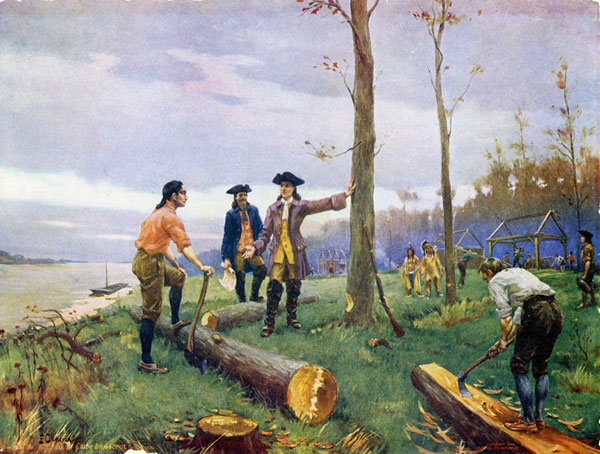The Founding of St. Louis
(1763-1764)
The Founding of St. Louis (1763-1764)
The quest for founding the city of St. Louis began in 1763, when a French merchant named Pierre Laclède Liguest, who had a monopoly on all trade along the Missouri River, left New Orleans in search of a place to establish a trading post. After storing his supplies for the winter at Fort de Chartres near present Prairie du Rocher, Illinois, Laclede set out with Auguste Chouteau, his 14-year-old lieutenant, in pursuit of a site.
Despite his original plan to establish a post near the mouth of the Missouri River, Laclede abandoned that idea after deeming the spot to be swampy marsh that frequently flooded. But just 20 miles downstream from the lowland, he came upon a bluff that rose almost 40 feet above the water, just downriver from the confluence of the Missouri and Mississippi Rivers.
When Laclede and Chouteau scrambled up the bluff to survey the area, they saw a forest of huge trees. To the west was a vast prairie with many small streams, and the southern view provided more streams and bluffs. The men also noticed the village of Cahokia, just across the Mississippi. Laclede decided to establish his post there and put notches in a handful of trees before heading back to the winter camp.
In early February 1764, after the icy river broke up enough to allow boat passage, Chouteau, accompanied by 30 men, returned to the bluff, with instructions from Laclede to clear the land of trees in order to build a trading post. With the felled trees, the crew constructed a warehouse and cabins. When Laclede visited in April to check on the progress, he gave the settlement the name “St. Louis” as a nod to King Louis IX of France.
The 1763 Treaty of Paris surrendered all territory east of the Mississippi to the British. The French villagers in Illinois, not wanting to be forced under British rule, soon crossed the river to settle around Laclede’s trading post. By year’s end, St. Louis boasted a population of 40 families.
[Source: Charles van Ravenswaay: St. Louis: An Informal History of the City and Its People, 1764-1865. St. Louis: Missouri Historical Society Press]
Rising Recognition and Emigration (1770 – 1803)
After its founding, St. Louis traded hands during the remainder of the 18th century. In 1770, the area, including St. Louis, transferred from the French to the Spanish, but later returned to French rule as the result of a secret treaty with Napoleon. Then, in 1803, St. Louis became part of the United States following the Louisiana Purchase. Legend has it that on the day St. Louis transferred from France to the United States, St. Louis flew under three flags—French, Spanish, and American.
In 1803, St. Louis also gained national recognition as the launching point for the Louisiana Purchase Expedition of Meriwether Lewis and William Clark. Soon after, New Englanders and East Coast emigrants started settling in St. Louis, but the population remained predominantly French well into the 19th century. The recognition of that French heritage continues to this day, as seen by the presence of the fleur-de-lis on the flag of St. Louis.
[Source: https://www.stlouis-mo.gov/visit-play/stlouis-history.cfm]
